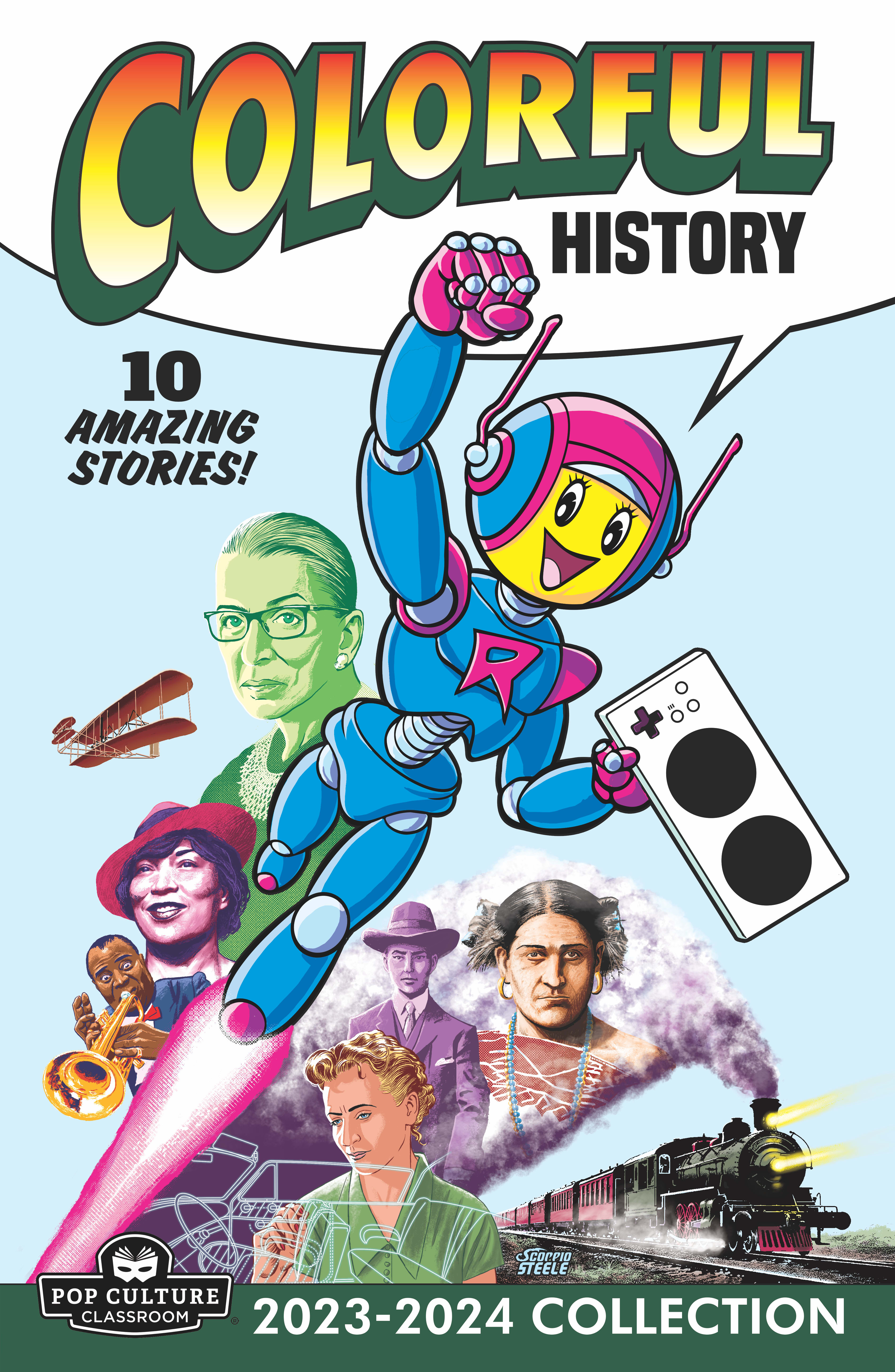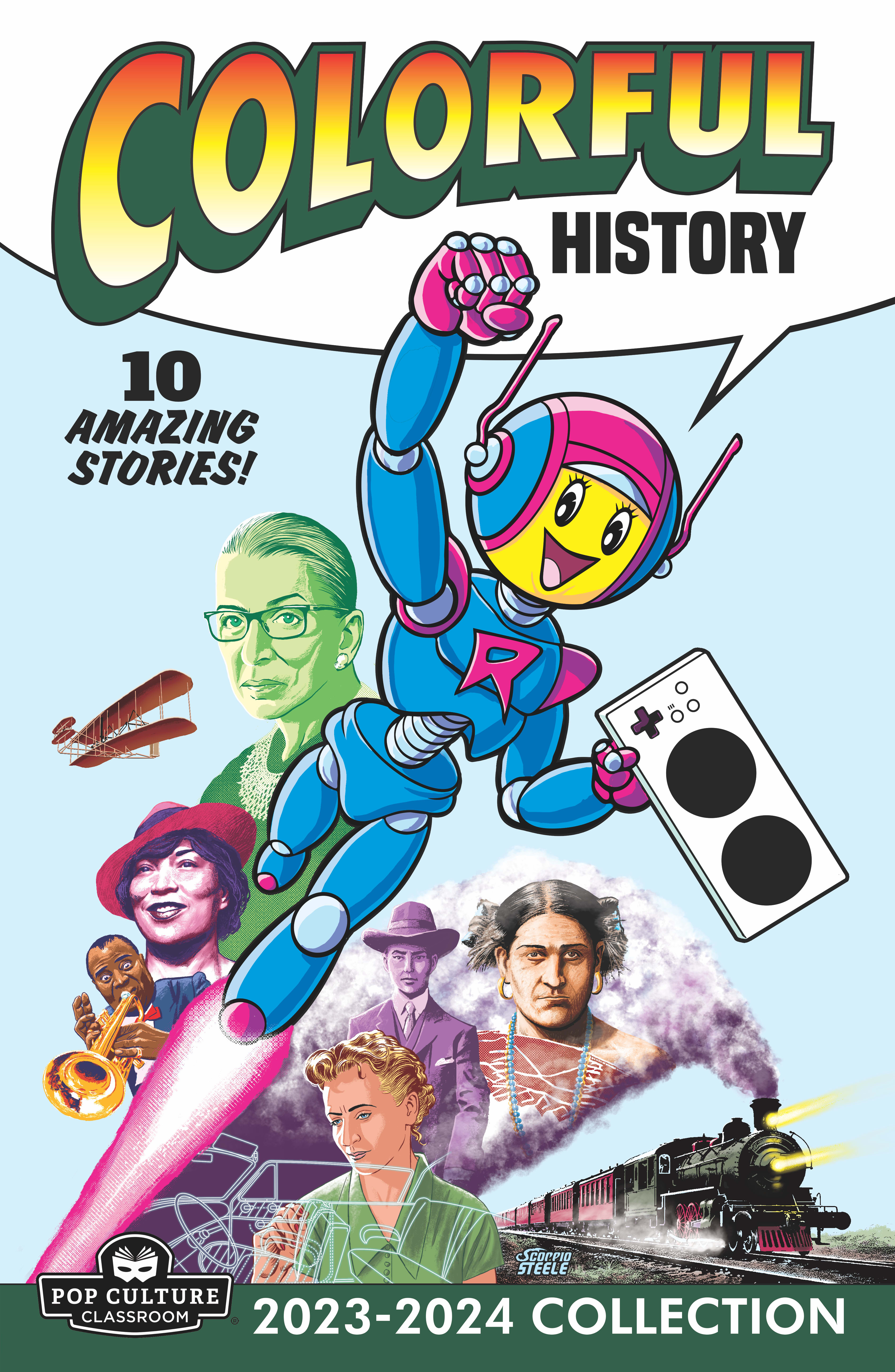Pop Culture Classroom is printing educational comics for teachers and students — and we need your help!
Our free Colorful History comics are already downloaded in pdf format thousands of times each year, helping teachers, librarians, and educators promote a richer understanding of U.S. History, increase literacy, and make learning more enticing. In 2023 alone, Colorful History was downloaded more than 3,300 times, engaging thousands of students!
![]()
However, we’ve listened to our teachers and supporters. They need physical copies of these educational comics, too!
Help Print Comics — and Get Your Own Printed Collection
![]()
Pop Culture Classroom needs $6,500 to print 1,250 collected editions of our popular Colorful History line of comics and put them in the hands of educators and students in the Denver metro area and beyond!
Our nonprofit will share free copies of the collection with a selection of our educational partners and at upcoming events. By backing this campaign, you will help give printed collections to:
-
700 educators and parents at local schools, libraries, workshops and other places where kids and teens learn
-
250 educators at Pop Culture Classroom’s free Educators' Days program at FAN EXPO Denver, July 4-7, 2024
To help us serve even more students with our year-round arts and education programs, we’ll make an additional 300 copies available for purchase on our website for $14.99 each.
![]()
The Impact of Your Support
With your partnership, we will collect all 10 issues released throughout 2023 and so far in 2024, and we’ll print them in a trade paperback format with brand new cover art from Denver artist Scorpio Steele (Image Comics’ Rain and cover artist for DC Comics’ Penguin #1).
Then, we’ll give these valuable comics collections to teachers and students through the events, gatherings, and professional development trainings PCC runs and attends each year.
By investing in this campaign, you’ll help make learning more interesting and accessible for the thousands of actual kids and educators that Pop Culture Classroom serves.
The Value of Colorful History
Pop Culture Classroom’s Colorful History is a series of educational comics about people, places, and events in U.S. History. Colorful History spotlights topics that are often taught in schools, as well as topics that appeal to students’ interests in popular culture.
The topics Pop Culture Classroom covers in the comics are…
-
Relevant. We not only pick topics that appeal to kids and teens—such as the real-world history behind the rise of anime's popularity in America, early home video games, and Dungeons & Dragons. Our issues also teach more complex topics—such as inflation, immigration and citizenship, and social movements—in demonstrative ways.
-
Grade level aligned. Comics are written specifically for elementary, middle school, or high school audiences depending on the topic.
-
Inclusive. From the Harlem Renaissance to the history of Two-Spirit people in the Americas, our comics highlight people and events from a range of communities and cultures that make up the United States and its people.
The collection includes 10 original Colorful History comics:
-
Anime in America: Anime’s popularity has soared in the U.S. Learn how it made the leap from Japan to America!
-
The Harlem Renaissance: Explore the story of the Harlem Renaissance and meet some of the Black writers, artists, and other creators whose work sparked a cultural revolution.
-
Ruth Bader Ginsburg and the U.S. Supreme Court: Learn about the iconic U.S. Supreme Court Justice Ruth Bader Ginsburg, the Supreme Court, and Justice Ginsburg’s advocacy for gender equality.
-
History of the U.S. Railroad: Ride the rails with Jimmie Rodgers, “The Singing Brakeman” as he explores the history of the train and railroad system in the U.S. — and considers its possible future.
-
A Two-Spirit (Indigenous Queer) Perspective: Learn about Two-Spirit people in the Americas with this comic’s Indigenous queer perspective on gender and identity.
-
Accessibility in Video Games: What is video game accessibility — and who benefits from it? See how changes in accessibility have allowed more people to engage with video games and their benefits.
-
The Wright Brothers: First to Fly: Read the story of Wilbur and Orville Wright’s pioneering efforts at flight — and the important role their sister Katherine played in bringing her brothers’ inventions to the world.
-
The World of A.I.: What is artificial intelligence, and how can it help or hinder society? Learn about the history of “thinking” machines, and how modern A.I does (and doesn’t) work.
-
Helene Rother: Automotive Pioneer : Written by H.S. students, this special collaboration details the life of Helene Rother, one of the first women to work in—and revolutionize—automotive design.
- Immigration at Angel Island (Coming Soon): Sarah learns her late great-grandmother's story of immigrating to the United States, and the story of Angel Island—an immigration station with a painful history that should not be forgotten.
Comics Are Educational — and Effective
With more than a decade of experience helping educators engage students using popular culture, Pop Culture Classroom knows that comic books and other graphic literature can provide unique educational benefits.
Research shows that comics can help students improve vocabulary and reading skills, better understand content, and better connect with subject matter:
- Graphic literature is a popular and growing medium recently surpassing 2 billion in annual sales and increasing consistently year over year (Gregory, 2023).
- Students have fun reading graphic literature! Because Graphic Novels are fun to read “they sustain student engagement and are often read more deeply than print text, along with producing greater comprehension retention” (Gregory, 2023).
- Researchers have also demonstrated that integrating comics and graphic works into curriculum afford greater dialogue in the classroom (Dallacqua & Sheahan, 2020), improve literacy practices (which are foundational to active learning of history, civics and government, and geography), (Gorman, 2003; Schwarz, 2003) including literacy practices in social studies (Bosma & Krueger, 2013),
- Graphic literature is also an ideal medium for teaching visual literacies (an important yet under taught skill in our increasingly visual world even though visual literacies are included in the Common Core ELA and Social Studies standards and the National Library Standards. (Gregory, 2023; Gorman, 2003). Engaging in multiple literacies evokes emotions in students helping them retain information while generating an appreciation for what Octavia Butler calls “the emotional reality of history” (NPR, 2021).
- Comics and graphic novels nurture students to become more critical consumers of history (Mathews, 2011; Schwarz, 2006), while gaining understanding that history is a complex process with individuals interpreting facts from subjective points of view (Cromer & Clark, 2007).
That’s why Pop Culture Classroom produces our Colorful History comic series and the standards-aligned teaching guides that come with each new issue.
It’s also why we’re asking for you to join with us today to print and publish our new Colorful History: 2023-2024 Collection and deliver these comics to more kids, classrooms, and libraries.
When you back this campaign at the $25 level or higher, you’ll also get your own paperback copy — or copies — of the collection to read and enjoy, or to give to your favorite student, school, classroom, library, or community organization.
Other Ways You Can Help







































































